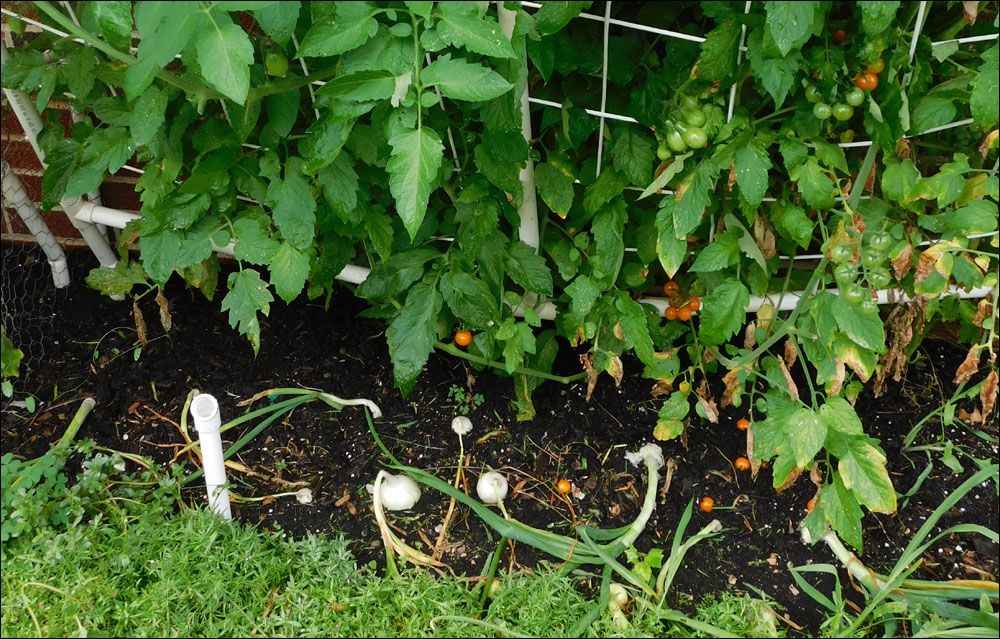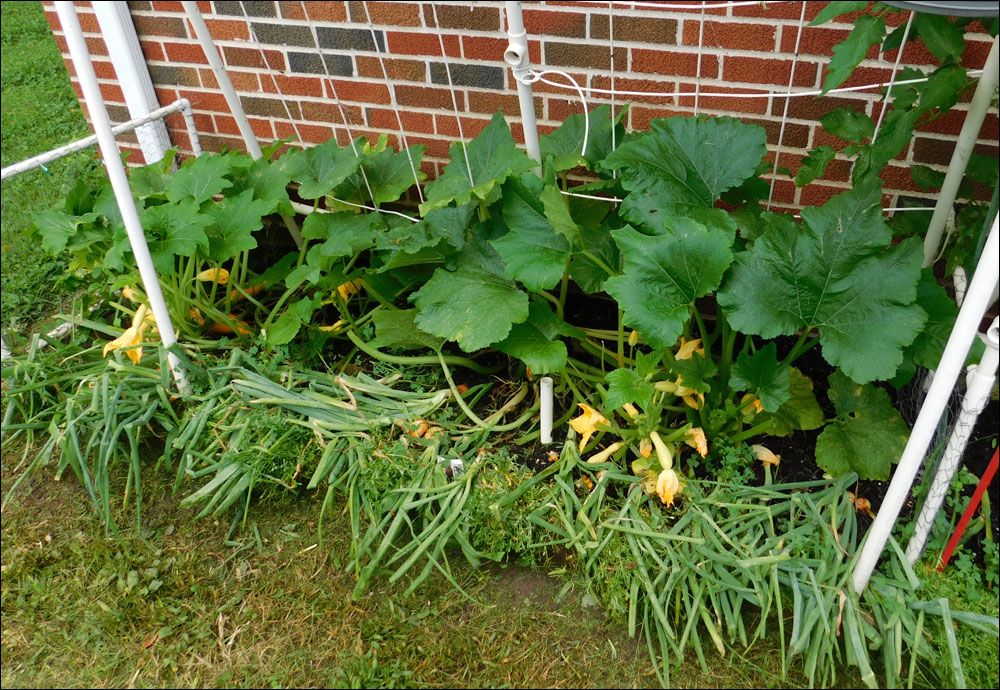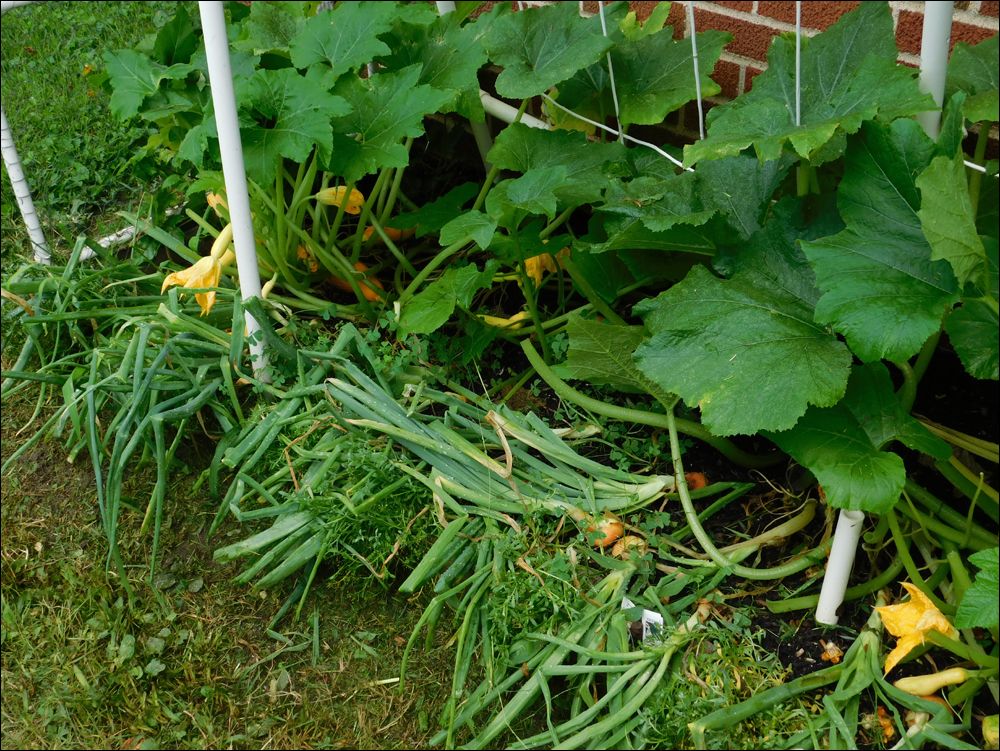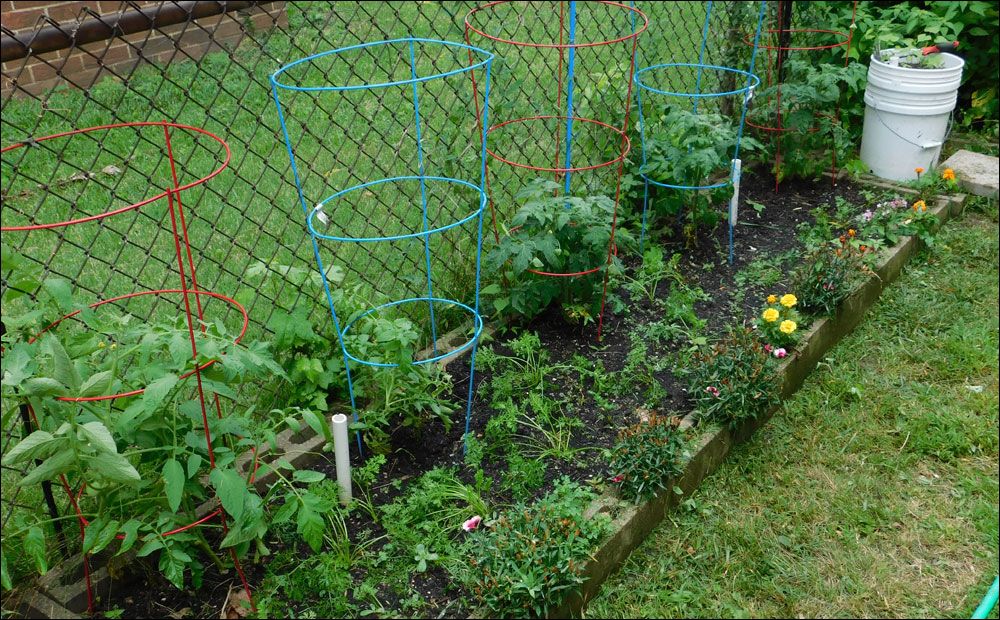Co-Habituating Plants in Small Raised Beds

I don't have a lot of space in my garden, just 5 raised beds of about 30 square feet each (10 long x 3 wide), so I often plant things under the recommended spacing and also put plants together very close. Here is some observations of what I've seen.
Onions and Cherry Tomatoes

Onions require some "me" time to get big enough to compete with companions. Their leaves are small and tall. Plant them a month or more before you plant what you want with them. Cherry tomatos are good if you have a trestle and are brutal about clipping any tomato branches which might over shadow the onions.
Here the tomatoes are on one of my wall beds and on a trestle. The onions never bulked up though. This could be because they didn't get enough sun. or this year was too wet. I'll keep watch on these for a later report.
Onions and Squash

Not the best combo, even planting onions a month before the squash. Squash tends to spread, very much. Probably better to give them their own bed. Putting them together, you must be ready to be brutal and trim back any leaves that grow over the onions. Though if you do that, it makes harvesting the squash easier. Squash seems to send a stalk towards the light. Keeping the leaves trimmed exposes the fruit and makes it easier to watch its development.

Keep an eye, animals like rabbits can eat early squash.
Carrots and Onions
Carrots and Onions do well if the onions are planted a month or more before the carrots. Carrots are bushy and can over shadow young onions. The one time I planted them together, the carrots quickly spread so much the onions died.
Carrots and Determinate Tomatoes

Tomatoes come in two types, determinate (which means they grow to a predeterminate height then stop), or indeterminate (which means they keep growing taller all season).
Pairing these two seems to work well, though I would plant the carrots a month early and be watchful of any leaves that might over shadow the carrots.
I will keep reporting on my mixes.
Sophie Gale
Fri, 02/07/2020 - 00:57
Permalink
Companion Planting Strawberries with Mushrooms
Companion Planting Strawberries with Mushrooms
https://practicalselfreliance.com/companion-planting-strawberries-mushro...
"Companion planting strawberries ensures that you get the most out of your garden space, while at the same time helping your berry plants succeed. While they’re often companion planted with herbs and flowers to either discourage pests or encourage pollination, why not companion plant your strawberries with mushrooms for better soil and higher yields?"
Sweet Tatorman
Fri, 02/07/2020 - 08:34
Permalink
I've grown these
I have grown the mushroom featured in this article, Stropharia rugosoannulata (which I believe is the preferred spelling vs what is in the article). For a mushroom it is fairly easy to grow on wood chips. The author failed to mention that these should be hardwood chips and fairly freshly chipped. A small percentage of conifer chips in the mix probably would be OK but I doubt that a dominate portion of conifer would do. As noted in the article it is possible to take a portion of the colonized chips and use to inoculate a fresh batch of chips. It is rare among cultivated mushrooms that this will work. It is rather like maintaining a culture of starter for sourdough bread. It is important to do it yearly as after a couple of years the Stropharia will have been run it's course in the original media. It would not surprise me if I have eaten at least 100 species of mushrooms. Except for the ones that have no flavor at all such as White Jelly fungus (Tremella fuciformis) or Witches Butter (Tremella mesenterica) while differing considerably in flavor most tend to have an underlying essence of mushrooms. I find that this Stropharia has a flavor considerably different from the rest of the lot. I like it a lot. It has a flavor that vaguely suggests asparagus.
Pay attention to the passage from the linked article about harvesting promptly. Once emerged they develop rapidly. I prefer them before the caps open. Eight hours can be the difference between prime quality and ineatably full of maggots.
Sweet Tatorman
Wed, 04/29/2020 - 11:08
Permalink
Found today on my morning walk
I had inoculated a pile of wood chips almost exactly one year ago using spawn from a semi-feral patch. Conditions were less than good as the "new" chips were not as fresh as I would have liked. No certainty of success but nothing to lose. Success! Found these this morning.
Blueday Jo
Sun, 02/09/2020 - 16:27
Permalink
Tomato Companion Planting
The classic pairing is tomato and basil - they seem to enjoy each other's company, and the basil happily grows up through the tomato leaves for stability. I also grow climbing beans next to my tomato plants and they twine up through the tomato bush. Only drawback is locating the beans among the tomato leaves. A friend of mine grew purple beans this year, so i might try that so i can see them among the tomato leaves. Cucumbers also like using well-staked tomato plants as a trellis. The other classic of course, is growing climbing beans up the corn stalks. I have tried this various ways, but now make sure that the corn is about waist high before planting the beans or the corn can be swamped by voracious beans.
I find garlic, carrots and parsnips grow well in the flower garden. I broadcast handfuls of parsnip and carrot seeds in the flowerbeds and wait to see what comes up (if you leave the carrots and parsnips to flower the bees love them, they look gorgeous in the garden, and they will self-seed everywhere). I poke garlic cloves into the flower beds and they pop up happily as well. I expect onions would grow well that way as well, but I haven't tried that experiment yet.
I like to grow an absolute jungle of vegetables together, but it's taken a few years of experimentation to see how and when to plant them so that everything gets a chance to thrive.
alice
Mon, 02/10/2020 - 07:44
Permalink
Rust disease of garlic and onions
Some of my experiments with growing onions and garlic in a small urban garden at our previous house taught me that rust, a fungal disease, affects garlic and onions when those are grown in part shade. One eco solution is apparently to plant where there is more light. And for salad onions and others eaten green/fresh probably not so critical. And of course not all the diseases we have up here at 52 N latitude, along with our mild maritime climate, will be relevant in other bioregions. I remember hearing from a fellow gardener in one of the Southern States that many of the traditional British crops need extra shade there as the summer days give too much sun intensity and the veg lose water too fast and lose condition.
LandLizard
Thu, 04/30/2020 - 18:59
Permalink
Good ideas
My garden is a hodgepodge of perennials, weeds, and vegetables. I’m hand digging more garden space, but sunny areas are limited and I’d like to be more efficient.
The concrete cylinders are around potatoes. There are fava beans to the right. The bamboo came from a neighbor and was to be for sugar snap peas which aren’t doing well. I’ll plant cucumbers soon.
LandLizard
Thu, 04/30/2020 - 19:03
Permalink
Close-up photo
Lettuce with onions between (planted a little late). The large plant toward the back is rattlesnake master, and elephant garlic is in front.
alice
Wed, 05/06/2020 - 08:48
Permalink
congratulations
Congratulations on your garden, keep up the good work. We only have a tiny space at this house, though it's sunny. I have been starting seeds for busier gardeners, mainly rainbow chard which is a really easy green crop in our climate, and salad leaves. I've been using a complete organic fertilizer mix based on the work of Solomon & Reinheimer in 'The intelligent gardener' and the leaves are really nice and robust. I just haven't really fed my crops properly before, I now realize.
Pic with a tray of rocket at the front, and a pot of minutina (buckshorn plantain) to the left, miner's lettuce early seedlings just above the rocket, a trough of chard seedlings, coriander/cilantro and parsley inside the cold frame, 25 pots with agretti seedlings under the enviromesh in front of the cold frame and a trough of lettuce at the back.
LandLizard
Sun, 05/17/2020 - 09:45
Permalink
Mineral fertilizer
Thanks for mentioning “The Intelligent Gardener”, Alice. I looked it up and found some interesting sites to explore and plan to order fertilizer from Black Lake Organics.
alice
Sun, 05/17/2020 - 14:37
Permalink
Awesome
Always glad to recommend something I found useful, it's a good feeling. Helps me justify my reading habit ;) Also I think Solomon & Reinheimer really onto something.
LandLizard
Thu, 07/30/2020 - 22:26
Permalink
I tried some too
Alice, I ordered some organic mineral fertilizer from Black Lake Organics and that stuff is Amazing. I was reading articles on the Soil Analyst Cooperative, and it was mentioned as a source. Maybe it’s been so long since I used fertilizer that I forgot how it helps.